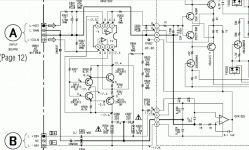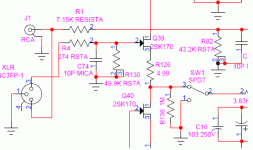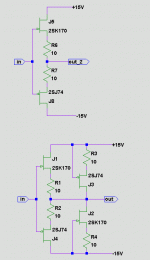Sigurd Ruschkow said:John, what do you think about the way Borbely does it in the attached schematics in my post 9236?
Sigurd
That schematic does NOT solve the problems/difficulties currently on topic. JC asked for serious input, while this one has no input buffers at all.
lumanauw said:Hi, Edmond,
You are creative
Thank you!
Back to JC's question. I saw this in Sony schematic. Diamond buffer closed in opamp's loop, like Walt Jung's line driver.
Hi David,
It's a better implementation of the same idea, i.e. in terms of distortion and less Johnson noise due to lower FB resistors. It's OK for me, but JC don't trust 'dirty sand' (ICs)
BTW, where are you John?
Cheers,
Edmond.
Mr. Curl,
Why is there no series resistor before C15/C74 (130p)? I've found this to be a problem when there is a coupling transformer (10k/10k) feeding the input. The sound become very harsh because the amp's input impedance is 0ohm at HF (the transformer can't handle this).
Why is there no series resistor before C15/C74 (130p)? I've found this to be a problem when there is a coupling transformer (10k/10k) feeding the input. The sound become very harsh because the amp's input impedance is 0ohm at HF (the transformer can't handle this).
I just woke up and all kinds of good stuff has been presented. PMA, thanks (I think) for showing an up to date input stage. It should answer many questions.
Edmond, your complementary follower approach is truly original and should be added to our arsenal of quality approaches. I recommend it to anyone, including Jam.
Edmond, your complementary follower approach is truly original and should be added to our arsenal of quality approaches. I recommend it to anyone, including Jam.
PMA said:Incomplete schematics.
What's the purpose of 1M resistor before the switch?
As you see, I've adopted your jfet buffer idea, but made it complementary. Now THD is ten times lower.
Edmond, I like how you add to LM damn fast buffer its complementary p-ch twin
Cheers
Wavebourn said:
What's the purpose of 1M resistor before the switch?
To define output of input buffer when -IN is switched to ground.
PMA said:
To define output of input buffer when -IN is switched to ground.
Anyway I don't understand: too high value to play any role...
Edmond Stuart said:
As you see, I've adopted your jfet buffer idea, but made it complementary. Now THD is ten times lower.
Hmm, I've redrawn the "Edmond buffer", see attached picture, bottom.
To me it looks like our well known complementary buffer (above) with two current sources capable of adding more output juice?
Just by simulating, I don't see much advantage for the "Edmond Buffer" even at fairly low load resistors.
But it makes offset trimming easier, as there is no need to screw around with the source resistors.
Nice idea.
Tino
Attachments
john curl said:..............
Edmond, your complementary follower approach is truly original and should be added to our arsenal of quality approaches. I recommend it to anyone, including Jam.
Hi John,
Thank you.
Is it a candidate for the next revision of JC1?
Original? Only partly, as the buffers are just a complementary version of your fet buffer. I think only the servo is new (AFAIK)
Cheers,
E.
Bs
Redrawn? 'Bad Science!'. You just spoiled it! That's why you don't see much advantage. Clearly, you don't understand my buffer (and your own crippled version).
zinsula said:Hmm, I've redrawn the "Edmond buffer", see attached picture, bottom.
To me it looks like our well known complementary buffer (above) with two current sources capable of adding more output juice?
Just by simulating, I don't see much advantage for the "Edmond Buffer" even at fairly low load resistors.
But it makes offset trimming easier, as there is no need to screw around with the source resistors.
Nice idea.
Tino
Redrawn? 'Bad Science!'. You just spoiled it! That's why you don't see much advantage. Clearly, you don't understand my buffer (and your own crippled version).
zinsula said:
To me it looks like our well known complementary buffer (above) with two current sources
But it makes offset trimming easier, as there is no need to screw around with the source resistors.
Exactly, I was about to post the same thing. And if the N and P JFETs are identical (as they ideally should), the current sources do precisely nothing.
I agree, the servo is very nice.
Edit: I've just noticed Edmond's message above and I have to admit I'm even more confused now. I'm waiting for an explanation.
More edit: I got it, I confused the source resistors rs1 and rs2. Now it makes sense - my fault for not looking closer.
Even more edit: Yes but rs1=rs2 so again if the N and P are identical, the whole thing doesn't make sense.
john curl said:Now, Now, look closer.
Right! First, look and think, then comment.
john curl said:.... Can't the 2 opposing current sources be replace with a 'difference' current source?
Why and how? The beauty of your buffer (or my complementary version) is a zero offset voltage (provided that the dual jfets have no offset, of course).
- Status
- Not open for further replies.
- Home
- Amplifiers
- Solid State
- John Curl's Blowtorch preamplifier


